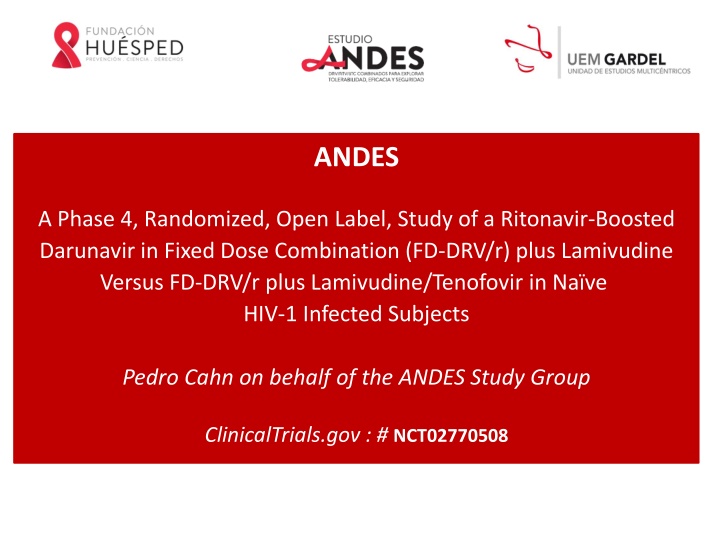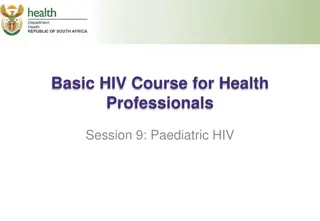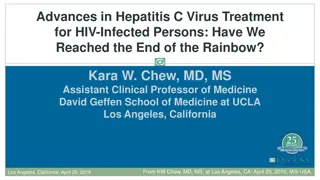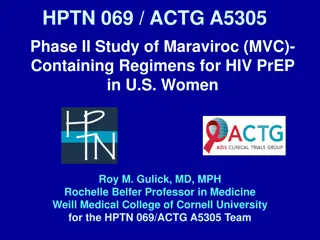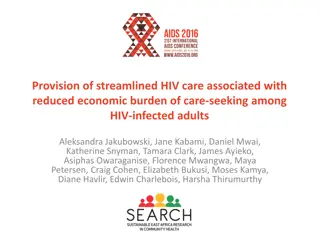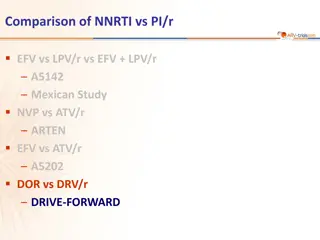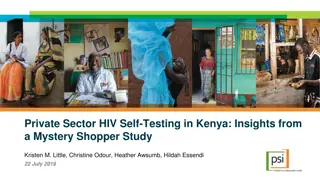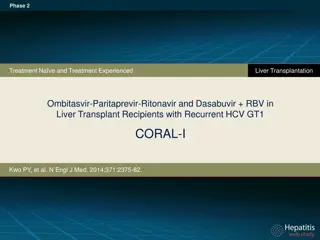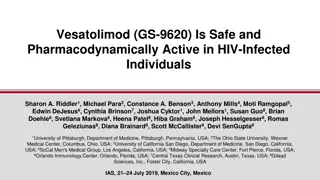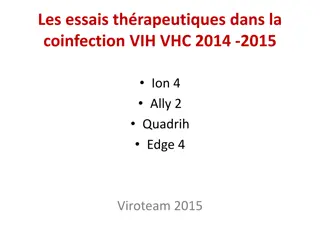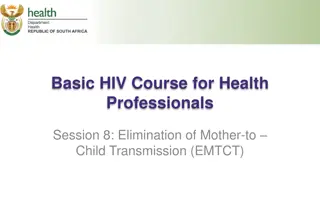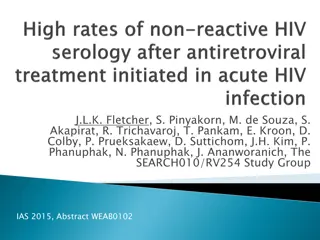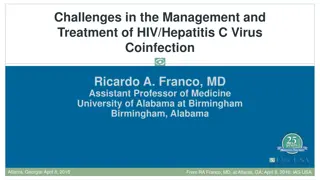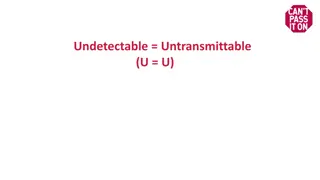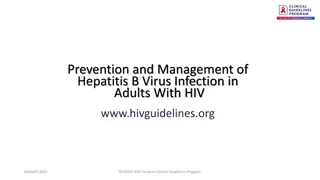Phase 4 Study of Ritonavir-Boosted Darunavir in HIV-1 Infected Subjects
Investigator-initiated Phase 4 study sponsored by Fundación Huésped, comparing efficacy and safety of ritonavir-boosted darunavir plus lamivudine to darunavir plus lamivudine/tenofovir in treatment-naive HIV-1 infected patients. The study aims to explore non-inferiority of the drug regimens and assess their impact on viral suppression and patient outcomes.
Download Presentation

Please find below an Image/Link to download the presentation.
The content on the website is provided AS IS for your information and personal use only. It may not be sold, licensed, or shared on other websites without obtaining consent from the author.If you encounter any issues during the download, it is possible that the publisher has removed the file from their server.
You are allowed to download the files provided on this website for personal or commercial use, subject to the condition that they are used lawfully. All files are the property of their respective owners.
The content on the website is provided AS IS for your information and personal use only. It may not be sold, licensed, or shared on other websites without obtaining consent from the author.
E N D
Presentation Transcript
ANDES A Phase 4, Randomized, Open Label, Study of a Ritonavir-Boosted Darunavir in Fixed Dose Combination (FD-DRV/r) plus Lamivudine Versus FD-DRV/r plus Lamivudine/Tenofovir in Na ve HIV-1 Infected Subjects Pedro Cahn on behalf of the ANDES Study Group ClinicalTrials.gov : # NCT02770508
About this study This is an investigator initiated study, designed, conducted and sponsored by Fundaci n Hu sped. Funding sources: Ministry Technology, Ministry of Health and Richmond laboratories, Buenos Aires, Argentina of Science and
Background Background The GARDEL study demonstrated non inferiority of a 2 drug regimen combining a boosted PI and lamivudine when compared to the standard of care HAART in treatment-naive patients. In virologically suppressed patients similar strategies showed non inferiority when compared to triple therapy (OLE, ATLAS-M, DUAL) ANDES study was designed to explore the efficacy and safety of ritonavir-boosted darunavir plus 3TC, compared to the same PI plus TDF/3TC in treatment-naive patients.
Why DRV/r plus 3TC? DRV/r is an potent antiviral compound with proven clinical efficacy in both treatment-naive and treatment- experienced HIV-infected patients. The genetic barrier of DRV is higher than other PIs. It is the preferred PI in most guidelines 3TC is a safe and well tolerated drug. It is cheap and generic. 3TC and DRV/r allow once a day dosing. Both drugs are well tolerated, with minimum monitoring requirement In Argentina a fixed dose combination(FDC) of DRV 800 mg plus ritonavir 100 mg is registered and approved to be used in treatment-na ve patients.
Generic FDC: Similar PK compared to branded DRV API supplier: Hetero drugs (India)
Study design Two phase design: Phase 1: A minimum of 140 participants required to study non-inferiority at 24 weeks (pVL <400 copies/mL) If at 24 weeks at least 75% of the participants achieve viral supression (<400 c/mL) in the experimental arm, the study will proceed to phase 2 Phase 2: 190 additional patients will be enrolled to explore non inferiority regarding the primary endpoint (<50 copies/mL at week 48)
Study design Phase 4, randomized, multicentric, open label study Wk 24 Wk 48 Stratified at screening by HIV-1 RNA ( or > 100,000 copies/mL) Interim analysis Primary endpoint Dual therapy DRV/r 800/100 mg QD + 3TC 300 mg QD (n= 75) ARV- naive patients, from 5 sites in Argentina 18 years HIV-1 RNA >1000 copies/ml No IAS-USA defined NRTI or PI resistance at screening* HB(s)Ag negative (N = 145) Triple therapy : DRV/r 800/100 mg QD + 3TC /TDF 300/300 mg QD (n=70)
Study endpoints Primary endpoint: Proportion of subjects with plasma HIV-1 RNA levels <50 copies/mL at week 48 using the FDA snapshot algorithm (Missing, Switch or Discontinuation = failure) for the ITT-exposed population Secondary endpoints: Percentage of patients with HIV-1 RNA <400 copies/mL at week 24 using the FDA snapshot algorithm Number and type of resistance mutations in case of virologic failure CD4+ lymphocyte count and change between baseline (defined as the average between screening and baseline visit values) and weeks 24 and 48 Frequency, type and severity of adverse events and laboratory abnormalities at week 24 and 48 . Changes in quality of life through two validated instruments: the Medical Outcomes Study HIV Health Survey ( MOS - HIV) and EuroQol 5D (EQ - 5D) at week 48
Patient Disposition at Week 24 182 SCREEENED 145 RANDOMIZED SCF : 37 (20%)* Triple therapy (TT) n:70 Dual therapy (DT) n:75 Discontinued:1 Discontinued 4 : Withdraw (1) ,SAE (1), LTFU (1) , RASH (1) LTFU(1) Completed W 24 Completed W24 69 (98,5%) 71 (95%) * Resistance, viral load < 1000 cp/mL, LTFU, other
Baseline Characteristics DT TT Global (N=75) (N=70) (n=145) Age 30 (25-39) 30 (24-42) 30 (26-38) Males 131 (91%) 70 (93%) 61 (88%) MSM/Bisexual 101 (73%) 53 (76%) 48 (71%) CDC Stage B* 11 (8%) 6 (8%) 5 (7%) Viral Load (log10) 4.5 (4.0-5.0) 4.6 (4.1-5.1) 4.5 (3.9-5.0) VL >100,000 c/mL 35 (24%) 20 (27%) 15 (22%) Median CD4 count 383 (286-562) 419 (290-564) 366.5 (275-544) (IQR 25-75) Shown are medians (IQR 25-75) for continuous variables or n(%) for categorical variables. Comparisons were performed by chi-sq test or t-tests. * No stage CDC C was enrolled
Viral load <400 copies/mL at week 24, ITT-e snapshot (n=145) 100 Triple Therapy Double Therapy TT:(97%) DT(95%) 80 Proportion (%) 60 Difference (95% CI): -2.5% (-7.9; 2.9) 40 20 0 0 4 8 12 24 Week Proportion of patients with plasma HIV-1 RNA less than 400 copies per mL Mean CD4+ increases were similar in both arms (DT=206 cells/mm3; TT=204 cells/mm3).
Patients with VL<400 c/mL at week 24 DT TT Difference (95% CI) 68/70 -2.5% ITT snapshot 71/75 (n=145) (97%) (-7.9; 2.9) (95%) On treatment 71/71 68/69 1.4% (n=140) (100%) (99%) (-0.9, 3.8) Discontinuations 4* 1** Virological failure 0 1 *Withdraw consent (1) ,SAE (1), LTFU (1) , RASH (1) ** LTFU
Patients with VL<400 c/mL at week 24 (Baseline VL> 100,000 copies/mL) DT (20) TT (15) Baseline VL > 100.000 c/ml ITT snapshot (100%) (100%)
Grade 2 & 3 Adverse Events Global (n:145) DT (n:75) TT (N:70) Total # AEs grade 2-3 AEs (possible probably drug- related )* 32 AEs in 26 patients (17,9%) 11 AEs in 10 patients (13,3%) 21 AEs in 16 patients (22,9%) 5 (6,7%) 6 (8%) 0 9 (12.9%) 5 (7.1%) 3 (4.3%) Gastrointestinal ** Dermatologic (Rashes)* Neurologic 14 (9.6%) 11 (7.5%) 3 (4.3%) SAEs: 8 5 3 2 During Study dosing period None considered drug related 3 During Screening period (CAP, Asthma, (CAP, diabetic foot) diverticulitis) *One patient was discontinued due to a drug-related grade 3 adverse event (rash) ** 4 patients had 2 GI events each.
Conclusions A generic combination of DRV/RTV in FDC plus 3TC showed non-inferiority on a secondary endpoint to a generic triple drug regimen of DRV/RTV plus TDF/3TC at 24 weeks in treatment- na ve patients. These results, if confirmed at week 48, may provide further evidence about the potential efficacy of dual therapy based on 3TC and a drug with a high genetic barrier.
Acknowledgments We thank everyone who has contributed to the success of this study, including in particular all study participants and their families Fundacion Huesped and UEM GARDEL Coordination Team: The ANDES Study Team: Investigators: . Fundaci n Hu sped: Mar a In s Figueroa, Mar a Jos Rol n, Omar Sued, Pedro Cahn Hospital Cosme Argerich: Diego Cechini, Ezequiel Cordova Hospital Italiano: Waldo Belloso, Marisa Sanchez Centro de Estudios Infectol gicos (CTD Stamboulian): Gustavo Lopardo Consultorio Infectol gico: Daniel Pryluka Valeria lvarez, Agustina Arg ello, Agustina Enz, Mariano de Stefano, Santiago Perez Lloret, Patricia Patterson, Carina Cesar, Valeria Fink, Emanuel Fojo, Horacio Beylis, Ana Gun Richmond laboratories: Elvira Zini Funding: Ministry of Science and Technology, Argentina; Ministry of Health, Argentina & Richmond Laboratories
